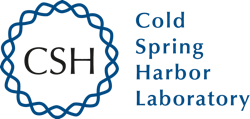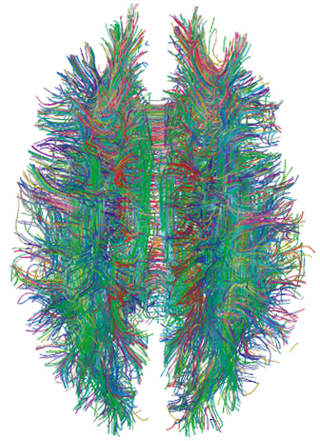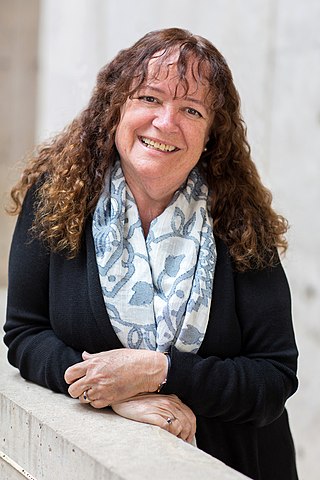Related Research Articles

Cognitive neuroscience is the scientific field that is concerned with the study of the biological processes and aspects that underlie cognition, with a specific focus on the neural connections in the brain which are involved in mental processes. It addresses the questions of how cognitive activities are affected or controlled by neural circuits in the brain. Cognitive neuroscience is a branch of both neuroscience and psychology, overlapping with disciplines such as behavioral neuroscience, cognitive psychology, physiological psychology and affective neuroscience. Cognitive neuroscience relies upon theories in cognitive science coupled with evidence from neurobiology, and computational modeling.
The development of the nervous system, or neural development (neurodevelopment), refers to the processes that generate, shape, and reshape the nervous system of animals, from the earliest stages of embryonic development to adulthood. The field of neural development draws on both neuroscience and developmental biology to describe and provide insight into the cellular and molecular mechanisms by which complex nervous systems develop, from nematodes and fruit flies to mammals.

Cold Spring Harbor Laboratory (CSHL) is a private, non-profit institution with research programs focusing on cancer, neuroscience, plant biology, genomics, and quantitative biology.
Brain mapping is a set of neuroscience techniques predicated on the mapping of (biological) quantities or properties onto spatial representations of the brain resulting in maps.
Mriganka Sur is the Newton Professor of Neuroscience and Director of the Simons Center for the Social Brain at the Massachusetts Institute of Technology. He is also a Visiting Faculty Member in the Department of Computer Science and Engineering at the Indian Institute of Technology Madras and N.R. Narayana Murthy Distinguished Chair in Computational Brain Research at the Centre for Computational Brain Research, IIT Madras. He was on the Life Sciences jury for the Infosys Prize in 2010 and has been serving as Jury Chair from 2018.

A connectome is a comprehensive map of neural connections in the brain, and may be thought of as its "wiring diagram". An organism's nervous system is made up of neurons which communicate through synapses. A connectome is constructed by tracing the neuron in a nervous system and mapping where neurons are connected through synapses.
Connectomics is the production and study of connectomes: comprehensive maps of connections within an organism's nervous system. More generally, it can be thought of as the study of neuronal wiring diagrams with a focus on how structural connectivity, individual synapses, cellular morphology, and cellular ultrastructure contribute to the make up of a network. The nervous system is a network made of billions of connections and these connections are responsible for our thoughts, emotions, actions, memories, function and dysfunction. Therefore, the study of connectomics aims to advance our understanding of mental health and cognition by understanding how cells in the nervous system are connected and communicate. Because these structures are extremely complex, methods within this field use a high-throughput application of functional and structural neural imaging, most commonly magnetic resonance imaging (MRI), electron microscopy, and histological techniques in order to increase the speed, efficiency, and resolution of these nervous system maps. To date, tens of large scale datasets have been collected spanning the nervous system including the various areas of cortex, cerebellum, the retina, the peripheral nervous system and neuromuscular junctions.
Hyunjune Sebastian Seung is President at Samsung Electronics & Head of Samsung Research and Anthony B. Evnin Professor in the Princeton Neuroscience Institute and Department of Computer Science. Seung has done influential research in both computer science and neuroscience. He has helped pioneer the new field of connectomics, "developing new computational technologies for mapping the connections between neurons," and has been described as the cartographer of the brain.
The White House BRAIN Initiative is a collaborative, public-private research initiative announced by the Obama administration on April 2, 2013, with the goal of supporting the development and application of innovative technologies that can create a dynamic understanding of brain function.
The MICrONS program is a five-year project run by the United States government through the Intelligence Advanced Research Projects Activity (IARPA) with the goal of reverse engineering one cubic millimeter—spanning many petabytes of volumetric data—of a rodent's brain tissue and use insights from its study to improve machine learning and artificial intelligence by constructing a connectome. The program is part of the White House BRAIN Initiative.
Anne K. Churchland is a neuroscientist at University of California, Los Angeles. Her laboratory studies the function of the posterior parietal cortex in cognitive processes such as decision-making and multisensory integration. One of her discoveries is that individual neurons in rodent posterior parietal cortex can multitask i.e. play a role in multiple behaviors. Another discovery is that rodents are similar to humans in their ability to perform multisensory integration, i.e. to integrate stimuli from two different modalities such as vision and hearing.
MAPseq or Multiplexed Analysis of Projections by Sequencing is a RNA-Seq based method for high-throughput mapping of neuronal projections. It was developed by Anthony M. Zador and his team at Cold Spring Harbor Laboratory and published in Neuron, a Cell Press magazine.

William Ronald Schafer is a neuroscientist and geneticist who has made important contributions to understanding the molecular and neural basis of behaviour. His work, principally in the nematode C. elegans, has used an interdisciplinary approach to investigate how small groups of neurons generate behavior, and he has pioneered methodological approaches, including optogenetic neuroimaging and automated behavioural phenotyping, that have been widely influential in the broader neuroscience field. He has made significant discoveries on the functional properties of ionotropic receptors in sensory transduction and on the roles of gap junctions and extrasynaptic modulation in neuronal microcircuits. More recently, he has applied theoretical ideas from network science and control theory to investigate the structure and function of simple neuronal connectomes, with the goal of understanding conserved computational principles in larger brains. He is an EMBO member, Welcome Investigator and Fellow of the Academy of Medical Sciences.

Spatial transcriptomics is a method for assigning cell types to their locations in the histological sections. This method can also be used to determine subcellular localization of mRNA molecules. The term is a variation of Spatial Genomics, first described by Doyle, et al., in 2000 and then expanded upon by Ståhl et al. in a technique developed in 2016, which has since undergone a variety of improvements and modifications.

Partha Pratim Mitra is an Indian-American neuroscientist and computer scientist. He is the Crick-Clay Professor of Bioinformatics at Cold Spring Harbor Laboratory. Mitra currently holds the H.N. Mahabala Distinguished Chair in Computational Brain Research at IIT Madras and he is a Senior Visiting Researcher at RIKEN, Tokyo, Japan.
Jeffrey D. Macklis is an American neuroscientist. He is the Max and Anne Wien Professor of Life Sciences in the Department of Stem Cell and Regenerative Biology and Center for Brain Science at Harvard University, Professor of Neurology [Neuroscience] at Harvard Medical School, and on the Executive Committee and a Member of the Principal Faculty of the Neuroscience / Nervous System Diseases Program at the Harvard Stem Cell Institute.

Margarita Behrens is a neuroscientist and biochemist. She is currently an associate professor at the Salk Institute for Biological Studies where her lab studies the impact of oxidative stress on the post-natal brain through probing the biology of fast-spiking parvalbumin interneurons in models of schizophrenia.
Lisa Gunaydin is an American neuroscientist and assistant professor at the Weill Institute for Neurosciences at the University of California San Francisco. Gunaydin helped discover optogenetics in the lab of Karl Deisseroth and now uses this technique in combination with neural and behavioral recordings to probe the neural circuits underlying emotional behaviors.

Patch-sequencing (patch-seq) is a method designed for tackling specific problems involved in characterizing neurons. As neural tissues are one of the most transcriptomically diverse populations of cells, classifying neurons into cell types in order to understand the circuits they form is a major challenge for neuroscientists. Combining classical classification methods with single cell RNA-sequencing post-hoc has proved to be difficult and slow. By combining multiple data modalities such as electrophysiology, sequencing and microscopy, Patch-seq allows for neurons to be characterized in multiple ways simultaneously. It currently suffers from low throughput relative to other sequencing methods mainly due to the manual labor involved in achieving a successful patch-clamp recording on a neuron. Investigations are currently underway to automate patch-clamp technology which will improve the throughput of patch-seq as well.

Susana Q. Lima is a Portuguese neuroscientist and principal investigator at the Champalimaud Centre for the Unknown in Lisbon, Portugal. Her research studies neural mechanisms of sexual behavior and mate choice.
References
- ↑ "CSHL Anthony Zador". Cold Spring Harbor Laboratory. Archived from the original on 20 December 2016. Retrieved 14 December 2016.
- ↑ "Sequencing the Connectome: Will DNA Bar Codes and a Sneaky Virus Change the Way Scientists Map the Brain?". Scientific American. 23 October 2012. Retrieved 14 December 2016.
- 1 2 "Mapmaking with barcoded neurons". Nature Methods. 31 October 2016. Retrieved 14 December 2016.
- ↑ "Neuroscience: The rat pack". Nature. 19 May 2010. Retrieved 14 December 2016.
- ↑ Zador AM, Dubnau J, Oyibo HK, Zhan H, Cao G, Peikon ID (2012). "Sequencing the Connectome". PLOS Biology. 10 (10): e1001411. doi: 10.1371/journal.pbio.1001411 . PMC 3479097 . PMID 23109909.
- ↑ Kebschull JM, Garcia da Silva P, Reid AP, Peikon ID, Albeanu DF, Zador AM (2016). "High-Throughput Mapping of Single-Neuron Projections by Sequencing of Barcoded RNA". Neuron. 91 (5): 975–87. doi:10.1016/j.neuron.2016.07.036. PMC 6640135 . PMID 27545715.
- ↑ "The Year of Changing Our Minds: The Leading Global Thinkers of 2015". Foreign Policy.
- ↑ "Government's 'Golden Fleece' Is Now Humanity's Golden Goose". The New York Observer . 19 May 2017.